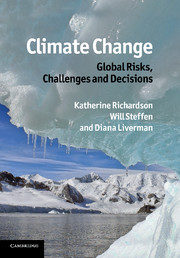Book contents
- Frontmatter
- Contents
- Writing team
- Foreword
- Preface
- List of acronyms and abbreviations
- Part I Climatic trends
- 1 Identifying, monitoring and predicting change in the climate system
- 2 The oceans and the climate system
- 3 Sea-level rise and ice-sheet dynamics
- 4 Carbon cycle trends and vulnerabilities
- Part II Defining ‘dangerous climate change’
- Part III Equity issues
- Part IV Mitigation and adaptation approaches
- Part V Meeting the challenge
- Index
- Plate section
- References
4 - Carbon cycle trends and vulnerabilities
Published online by Cambridge University Press: 04 April 2011
- Frontmatter
- Contents
- Writing team
- Foreword
- Preface
- List of acronyms and abbreviations
- Part I Climatic trends
- 1 Identifying, monitoring and predicting change in the climate system
- 2 The oceans and the climate system
- 3 Sea-level rise and ice-sheet dynamics
- 4 Carbon cycle trends and vulnerabilities
- Part II Defining ‘dangerous climate change’
- Part III Equity issues
- Part IV Mitigation and adaptation approaches
- Part V Meeting the challenge
- Index
- Plate section
- References
Summary
‘We are only a tool in the cycle of things … (we) go out into the world and help keep the balance of nature. It's a big cycle of living with the land, and eventually going back to it …’
The Earth's element cycles – nitrogen, carbon, phosphorus, sulphur, silicon and others – are central to the functioning of the climate system, and to life itself. In the context of climate change, the carbon cycle has assumed centre stage, primarily through the rapid rise in human-induced emissions of the important greenhouse gases carbon dioxide (CO2) and methane (CH4). The political debate on responses to the climate change challenge has focused primarily on one aspect of the carbon cycle – reducing the emissions of CO2 to the atmosphere. However, the carbon cycle is very complex and human activities affect other parts of the cycle – for example, the ability of natural processes on the land and in the ocean (carbon ‘sinks’) to take up a significant fraction of the CO2 emitted to the atmosphere. The human imprint also operates indirectly on the carbon cycle via climate change itself, as several important feedback processes are predicted to be activated as the planet warms. For example, pools of carbon in the natural world, such as the CH4 stored in frozen soils in the northern high latitudes, that have hitherto been stable could become an important new source of a powerful greenhouse gas as the planet warms.
Information
- Type
- Chapter
- Information
- Climate Change: Global Risks, Challenges and Decisions , pp. 75 - 98Publisher: Cambridge University PressPrint publication year: 2011
